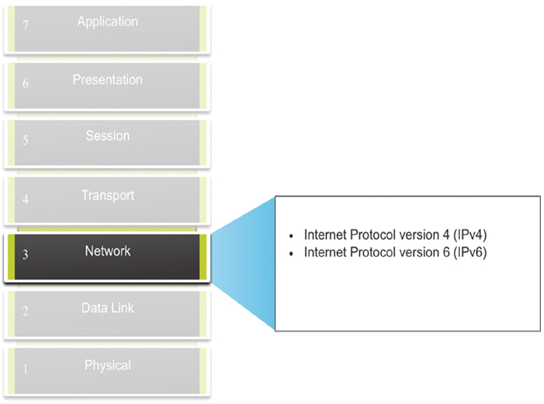Upon completion of this chapter, you will be able to answer the following questions:
• How does the network layer use IP protocols for reliable communications?
• What is the role of the major header fields in the IPv4 packet?
• What is the role of the major header fields in the IPv6 packet?
This chapter uses the following key terms. You can find the definitions in the Glossary.
Internet Control Message Protocol (ICMP)
maximum transmission unit (MTU)
Hi again! Bob also had to learn a lot about the network layer in his courses before he became an IT specialist. The network layer, or OSI Layer 3, provides services to allow end devices to exchange data across networks. IPv4 and IPv6 are the principal network layer communication protocols. Network layer protocols perform four operations: addressing end devices, encapsulation, routing, and de-encapsulation.
That sounds like a lot of information to people like Marcy and Vincent who do not have a knowledge of networking! Does it sound overwhelming to you? This module will help you to understand the network layer.
Network Layer Characteristics (22.1)
This section will introduce the protocols and functions of the network layer. The function of the network layer is to facilitate the transport of data from one network to another. This topic will introduce elementary functions of the network layer.
Video – Data Encapsulation (22.1.1)
Refer to the online course to view this video.
The network layer, or OSI Layer 3, provides services to allow end devices to exchange data across networks. As shown in Figure 22-1, IP version 4 (IPv4) and IP version 6 (IPv6) are the principle network layer communication protocols. Other network layer protocols include routing protocols such as Open Shortest Path First (OSPF) and messaging protocols such as Internet Control Message Protocol (ICMP).

Figure 22-1 Network Layer of the OSI Model
To accomplish end-to-end communications across network boundaries, network layer protocols perform four basic operations:
• Addressing end devices — End devices must be configured with a unique IP address for identification on the network.
• Encapsulation — The network layer encapsulates the protocol data unit (PDU) from the transport layer into a packet. The encapsulation process adds IP header information, such as the IP address of the source (sending) and destination (receiving) hosts. The encapsulation process is performed by the source of the IP packet.
• Routing —The network layer provides services to direct the packets to a destination host on another network. To travel to other networks, the packet must be processed by a router. The role of the router is to select the best path and direct packets toward the destination host in a process known as routing. A packet may cross many routers before reaching the destination host. Each router a packet crosses to reach the destination host is called a hop.
• De-encapsulation — When the packet arrives at the network layer of the destination host, the host checks the IP header of the packet. If the destination IP address within the header matches its own IP address, the IP header is removed from the packet. After the packet is de-encapsulated by the network layer, the resulting Layer 4 PDU is passed up to the appropriate service at the transport layer. The de-encapsulation process is performed by the destination host of the IP packet.
Unlike the transport layer (OSI Layer 4), which manages the data transport between the processes running on each host, network layer communication protocols (i.e., IPv4 and IPv6) specify the packet structure and processing used to carry the data from one host to another host. Operating without regard to the data carried in each packet allows the network layer to carry packets for multiple types of communications between multiple hosts.
